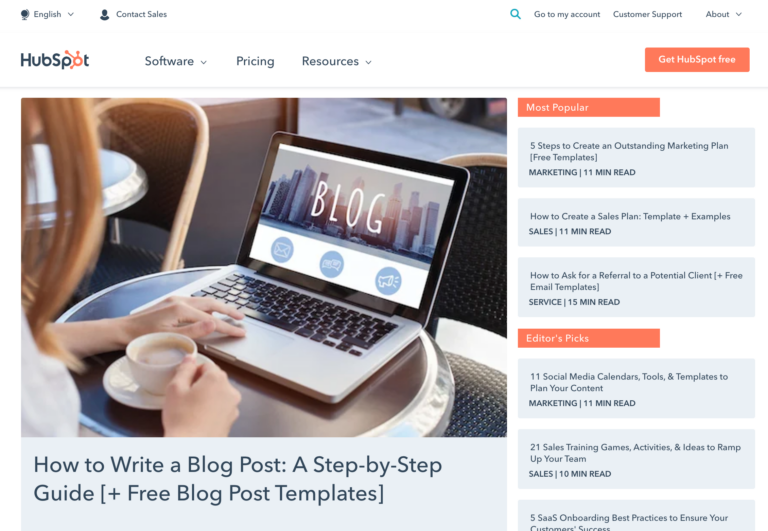Content Teardown: From Unpublished to #1 in 7 Weeks
Part of my Q2 2021 goal at Friday was to publish 50 posts and product pages:
I'm going to try & publish 50 pieces of content for @fridayhq in Q2
This will be blog posts, product pages, maybe a few videos
I have a few in the queue too, but it's time to publish
— Josh Spilker 🏄♂️ (@joshspilker) April 2, 2021
That may not sound like a lot if you’re in a big organization, but on my team (me, freelance writers, and a content intern) it’s huge.
On that same day as the above tweet, I published this post on daily planner apps.
2/50
Best daily planner apps! https://t.co/GItSxvKe3D#productivity
— Josh Spilker 🏄♂️ (@joshspilker) April 2, 2021
I thought it was a good piece and we had a good chance to rank.
Right now, the post is averaging hundreds of sessions per day is converting above an average rate and is a key driver in our new sign-ups.
Here’s a screenshot from Ahrefs:

Honestly, I didn’t think it would get to #1 in 7 weeks and gain more than 1500 keywords. That’s the truth.
If I could do it repeatedly and have posts rank #1 like clockwork, I would of course do it.
How did we make it happen?
A couple of caveats:
I can’t really explain the technical SEO details. I’m not that person. But we did recently change our CMS from an out-of-the-box solution to a more customized, headless CMS and that is reaping benefits.
Also, our AHREFS Health score and PageSpeed Insights are faring well. I don’t have a lot of control over those elements right now, but I think they contributed to our success.
In this post, I’m focusing more on the content marketing aspect.
It boils down to these 5 elements:
- Product
- Keyword Selection
- SERP framing
- Batch publishing & velocity
- Dedicated landing page
1. Specific Product
Friday is ranking number one for “daily planner apps” and I think part of that success is the Planner in our product. Google recognizes that our product matches the buyer intent. The conversion rate bears that out.
If you look at the SERPs (screenshot from early June 2021), not much of the content competition has a planner as a core product. They are editorial and review sites. Those obviously have value, and those sites capture lots of keywords for lots of things they don’t have a product before.
However, it seems right now that Google may be favoring the service providers over the editorial sites, at least in this case. That won’t necessarily be true for each keyword, which is why it’s important to look at the SERPs.

2. Keyword Selection
My focus was on the keyword “daily planner apps.”
Not “planner” or “daily planner.”
I could tell the differentiation mattered. Those are short-tail, massive head terms that will take a lot of moxie and domain authority to rank. I knew we didn’t have a chance out of the gate.
And once I looked at the SERPs for that keyword (more on that below), Google favored paper planners–something we didn’t offer. It didn’t make sense to tailor my post to the intent of the “daily planner.” Sure, I may have been able to rank for it (Friday is on the 2nd page, and I’m trying to bust through!) but the users may have been disappointed because the product didn’t match the intent. And as you can see below, it takes a lot of backlinks to get there (unless you’re Google). Still, if we get through the volume will be nice.
SERPs from Ahrefs:
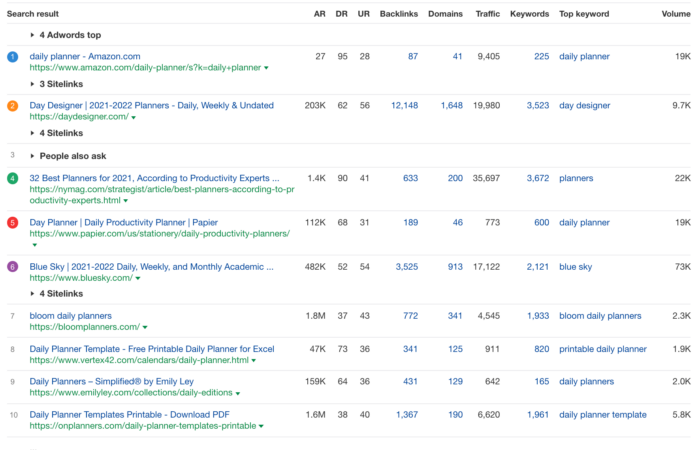
It made more sense to go after a longer keyword, like “daily planner apps.”
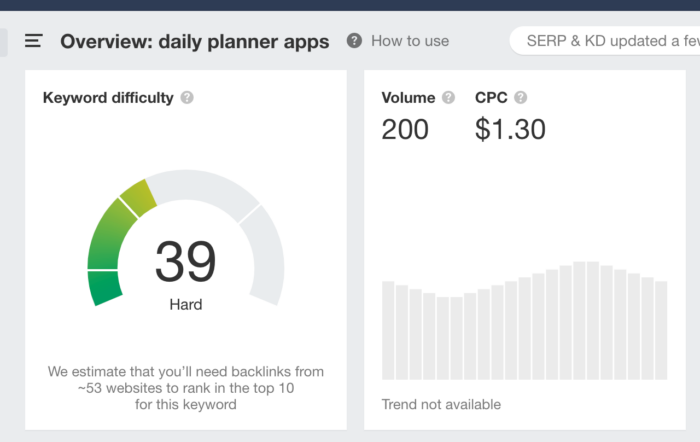
Side note: The volume for the word on Ahrefs is much less than that of Keywords Everywhere. Always use more than 1 tool! The volume isn’t quite this high either–the answer, like a lot of things, is somewhere in the middle.
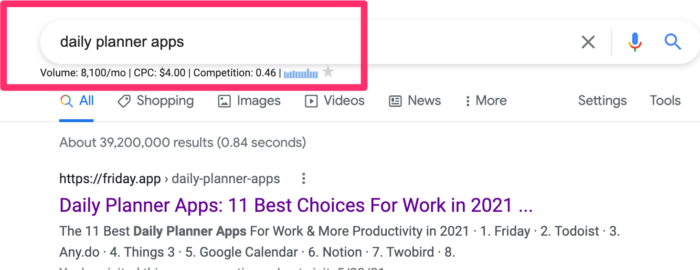
3. SERP framing
I think I’ve had arguments about this on Twitter (no arguments, just comments) but I think it’s really hard to go against the SERP.
When viewing this word, I knew it had a lot of potential.
The volume was good, the competition was decent but I thought our product would fit the inquiry, making this one of the rare mid-funnel (consideration) posts that could also lead to many conversions.
When I found this keyword and the potential for Friday, I noticed that its SERP (see above) was heavily populated with list posts and it seemed very similar to the ClickUp post on free project management software.
Not everyone likes list posts or alternative-positioning, but if you’re trying to find product market fit or want faster results, give it a try.
Here’s why it works for content marketers:
High intent: If someone searches for “daily planner apps” or “best daily planner apps” those words have higher buying intent. Maybe not as much as if it were a name brand (you can use that tactic with COMPANY X ALTERNATIVES), but it still shows a higher level of interest.
Here’s why it works for users:
Users want to compare options: You can provide that to them. You will have some bias, most users I think know that and we provide multiple options.
The friction is minimal. Users are willing to try new things in this space and with Friday since it’s a freemium offering. People are more willing to try a freemium product, and if it doesn’t hook them then they’ll try something else.
There are times when you can go against the SERP, but if you have a lower domain compared to your competitors, it’s better to stick with what’s working.
Sidenote: I haven’t really mentioned the post research and creation. I have a whole process for that, and it definitely plays a part. I’ll write about that in the future. I used Frase and MarketMuse to help put this post together. I use those 2 tools on most of the content I create, and neither one of them guarantees success, but they do help.
4. Publish Topic Clusters Fast
Right around the same time I published that post on daily planner apps, I had several other posts on planners that were either just published or ready to go:
- Types of planners (Currently #1 for “types of planners”)
- Digital planners (1st page for several good terms)
- How to use a planner for work (1st page)
- Several customized, landing pages for their own search terms
I think(?) this would be considered a topic cluster.
Part of the reason for this is that launching the planner was one of our biggest feature launches of the year.
However, it’s beneficial to give Google a lot: this establishes credibility and expertise (you know that E-A-T thing). It’s harder to do that from scratch (like I was doing with this topic) which is why I wanted to publish a lot of content at once and have it interlinked together.
Also, there’s a lot of talk about pillar pages, and I’ve seen that work with varying success (though sometimes I don’t even know I’m building pillar pages).
However…not as many people discuss how quickly you should publish. That’s part of why I wanted to do 50 pieces of content in Q2…to hyper grow our content surface area, and to see if content velocity has an effect.
This is hard to measure, but it looks like content velocity has an effect. Nick Jordan from Content Distribution has been on this train for awhile (and he has better charts to show you).
If you’ve read this far: here’s a quick secret–it wasn’t part of my original plan to publish this quickly. But I knew we needed to start seeing results. And Google was our main channel (instead of social, community, demand gen, etc). So Google doesn’t care when you publish. If you publish 3x a day or 30x a week, your “readers” won’t know because they’re finding you via search.
Don’t be nervous about publishing often. But only once you have your process down. You will make mistakes, but the beauty of online content marketing is you can quickly change any of those.
5. Link to a Dedicated Landing Page
This page was designed as our site product page, but we also targeted it early on for linkbuilding, and conversions.
The slug, metatitle, metadescription, and first H1 header all have the words “daily planner” in them.
I created the post “daily planner apps” to go back to a landing page that re-emphasized daily planners.
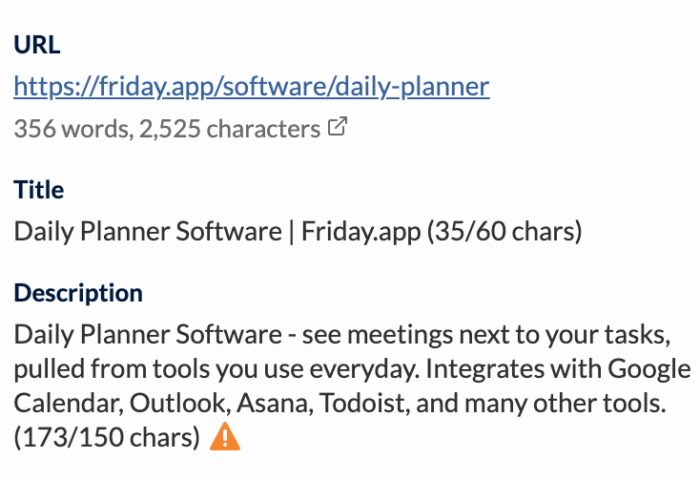
Marketers are very good at creating intentional landing pages for paid ads, but not so much for content marketing and blogging.
Usually—and I’ve done it before — is that I often link my very specific blog post to a very generic landing page or only the homepage. If the user is willing to click-through, they deserve a bit more information and convincing. The homepage won’t usually provide that context to thee specific query (as always, it depends)
If we think of our content marketing post more like an ad, then it makes sense that we would follow through with a dedicated landing page. Could the page above be improved from a conversion standpoint? For sure (though it’s not doing too bad). The point is not to make it perfect–there’s plenty to optimize there, too–but it’s better than a generic landing page.
Friday has a lot of capabilities as an asynchronous remote operating system–that’s a mouthful that is world’s away from a daily planner. Our positioning is different for individual accounts compared to teams and companies, and our landing pages have to speak to that. It’s why only linking to the homepage wouldn’t work for someone just looking to get a daily planner app.
Building links to product pages? Not impossible.
It’s hard to build links to product pages, but you don’t know if you don’t ask. I was able to get do-follow links from a DA 83, 75, and 63 plus others. I sought a few of those, but other requests came my way and there was a natural fit based on anchor texts, etc.
Because of those links, and the content, the landing page was also able to rank and then I sent my internal links to it within my newly minted high-ranking post. (in that case, it was fairly easy for my specific keyword: daily planner software).
It’s hard to know the symbiotic relationship here. But I do think a dedicated landing page helped with conversions and the internal linking match, which shows the Google algorithm that this search query is relevant to our site.
Takeaways:
- Connect your keywords to your product in some way
- Frame your content like the content in the SERPs
- Publish multiple pages on a topic (topic clusters)
- Publish faster than you want, especially when starting out
- Create a dedicated landing page for your most important blog posts

